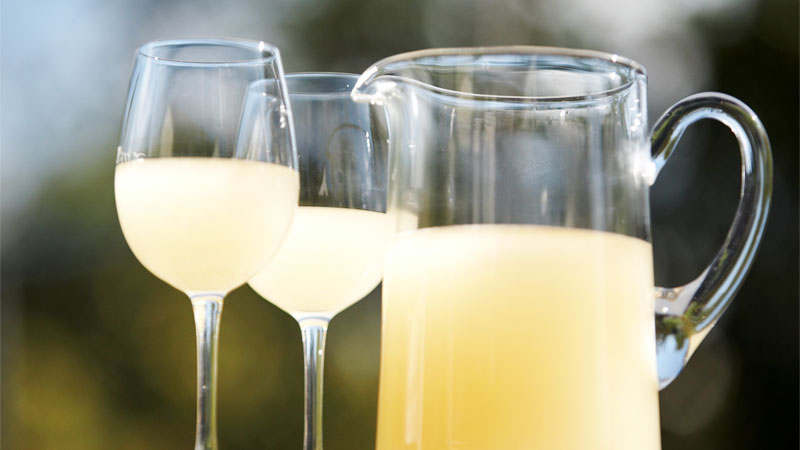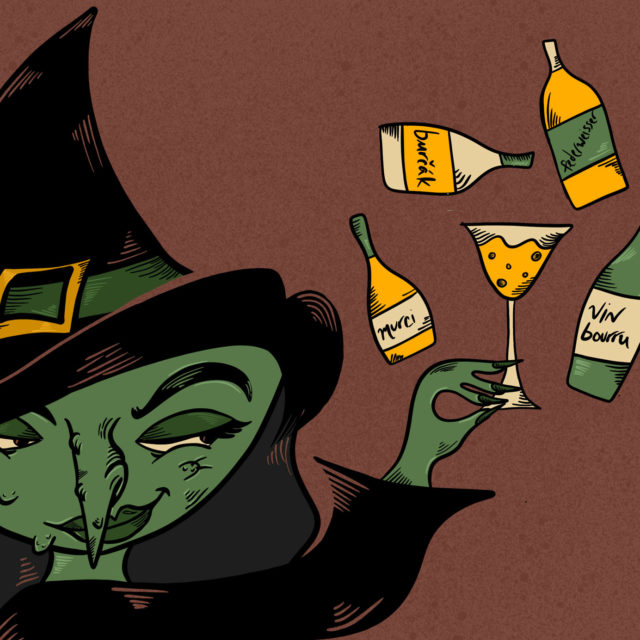As winemakers work on this year’s harvest, wine lovers will have to wait months — if not years — until they can sample the 2019 vintage. But in many Old World wine regions, there’s no need to wait.
Instead, those wine lovers will celebrate the new harvest by drinking the recently crushed, still-fermenting grape juice long before it could be considered anything close to a real wine. Known as federweisser and other names in German, vin bourru in French, burčák in Czech, and murci in Hungarian, partially fermented grape must is a favorite European thirst quencher from mid-September through the end of November, depending on the timing of the harvest.
It is also known to be rather wicked.
“It’s just semi-fermented grape juice — cloudy, refreshing, and sweet,” says Richard Stávek, an Autentisté winemaker in Moravia, Czech Republic, where burčák is everywhere at this time of year. “But it is very dangerous to drink because the sweetness and the CO2 make it very easy to get drunk quickly, and maybe to get sick.”
If you’re thinking of something like a nouveau or vin de primeur akin to Beaujolais Nouveau, think again. By most standards, Beaujolais Nouveau actually resembles real wine. Fermenting grape must is cloudy, fizzy, sugary-sweet and unstable, offering alcohol levels that can vary from 2 to 10 percent, though it is most commonly consumed with a beer — say, 4 or 5 percent. That variation is partly why it’s known for causing hangovers: If the amount of alcohol is actually increasing from hour to hour, it’s hard to get a handle on what constitutes a safe serving.

Federweisser is often seen in its white wine form, reflecting the roots of its most common name, which stems from the German feder, or feather, and weiss, meaning white. It can also be made from young red wine (and is thus called, in some places, federrotter). In the German-speaking countries where it appears to attain its greatest popularity, other names include sturm or storm — suggesting both the cloudy nature of the drink and the possibility of a thunderous, morning-after headache — as well as suser, sauser, neuer wein and junger wein.
Federweisser and its various synonyms are said to be very healthful, filled as they are with living yeast, lactic acid bacteria, and plenty of B vitamins. As a cloudy, freshly pressed grape juice, it is also extremely rich in fiber.
Although it is widely celebrated as the first sample of the yearly vintage, still-fermenting grape juice doesn’t appear to be taken very seriously by many in the wine world. A lone entry on federweisser earns just a two-sentence description as a German and Austrian specialty in the all-encompassing “Oxford Companion to Wine,” and it is not covered at all in most other large-format wine books.
Noting that the drink is very cheap to make, Stávek says that he doesn’t sell any burčák himself, strongly suggests avoiding versions of unknown origin, and adds that he doesn’t really like the culture of drinking it. That feeling seems to be widespread. When I called up one well-known regional winemaker to ask about federweisser, he immediately got off the phone.
Though it might not get much respect from cognoscenti, federweisser is clearly popular among just plain folks, with a seasonality that makes it ideal for fall harvest celebrations. In the wine-loving German region of the Palatinate, festivals focusing on federweisser start in September and run through October, culminating with Landau’s 100,000-visitor Fest des Federweissen on the third weekend of October. The revered Mosel region’s Federweissenfest takes place in the town of Cochem over two weekends in November, serving plenty of fermenting Riesling juice along with the traditional accompaniment of zwiebelkuchen onion tarts.
The celebrations extend far beyond Germany. Festivals dedicated to murci take place in Vecsés and around Hungary. The Czech Republic’s winemaking town of Znojmo holds an annual Burčákfest. The Côte d’Or town of Nuits-Saint-Georges hosts its own Fête du Vin Bourru.
At Cochem’s tourist information office, Meike Bauermann says that the festival is the perfect end to the tourist season.
“Just come and enjoy the zwiebelkuchen with the federweisser,” Bauermann says. “Sit by the Mosel river and enjoy the last sunbeams of the year. It’s very cozy.”
Once you grasp its ethereal nature, it’s easy to understand why the drink is rarely written about. Federweisser and its equivalents are around for only a few days. They do not require ratings or reviews. They cannot be easily commoditized or even packaged, due to their ongoing fermentation and increasing amounts of carbon dioxide. They cannot be sold at a later date, since they don’t exist as such at any later date. They’re ready to be enjoyed, but only for a brief time.
If you find yourself in an Old World wine region this fall, that time might be right now.
